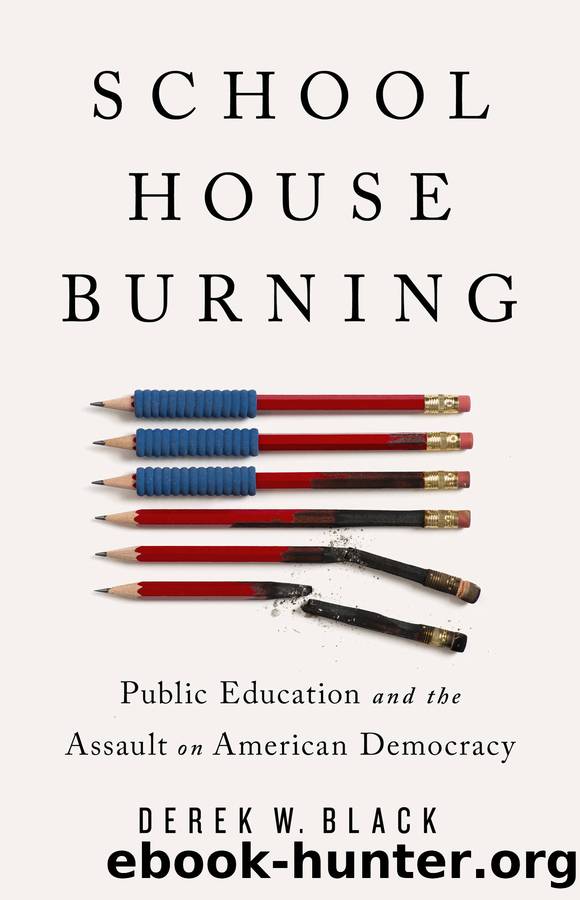Schoolhouse Burning by Derek W. Black

Author:Derek W. Black [W. BLACK, DEREK]
Language: eng
Format: epub
Publisher: PublicAffairs
Published: 2020-09-22T00:00:00+00:00
CHAPTER 7
THE SECOND RECONSTRUCTION
IF SEGREGATED EDUCATION WAS THE LYNCHPIN OF DISCRIMINATION and second-class citizenship, dismantling school segregation was the key to forcing America’s recommitment to the democratic path first envisioned following the Civil War. The civil rights movement of the mid-twentieth century has so many parallels to Reconstruction that scholars often called the movement the “Second Reconstruction.” Just like the freedmen following the Civil War, the NAACP and its allies later thought that if they could secure equal education for African Americans, equal citizenship would follow.
In 1922, the NAACP got a huge boost when a group of wealthy white liberals pulled together $100,000 to donate to the cause. The donors wanted to support “a large-scale, widespread, dramatic campaign to give the Southern Negro his constitutional rights, his political and civil equality, and therewith a self-consciousness and self-respect which would inevitably tend to effect a revolution in the economic life of the country.”1 The very first step, the group believed, was making segregated public schools too expensive to operate. Courtroom victories, in particular, would “give courage” to African Americans and focus the nation’s attention “like nothing else… upon vicious discrimination.”2 The NAACP, however, not white liberals, was the appropriate group to execute the campaign.
With money in hand, the NAACP began detailing strategy and soliciting counsel from some of the nation’s best legal minds. The NAACP’s legal committee asked Felix Frankfurter, who later became a Supreme Court justice, what he thought of a litigation strategy. Frankfurter told them to ask Charles Hamilton Houston, the dean of Howard Law School, first.3
Houston’s family was steeped in history, practical experience, and legal expertise. Born in 1895, the year before the Court decided Plessy v. Ferguson, he saw firsthand the devastation that segregation worked on African Americans and American democracy. But he was also born into a remarkable family. Houston’s father, William LePré Houston, grew up during Reconstruction, graduated from Howard Law School in 1892, and founded Washington DC’s first black law firm.4 Charles Hamilton Houston’s grandfather, Thomas Houston, was born into slavery in Kentucky and an amazing man in his own right, teaching himself to read and write and escaping to freedom in Illinois. He later worked as a conductor in the Underground Railroad and then as an assistant to Ulysses Grant. He even served as “an honorary pallbearer” when President Lincoln’s body was brought home to rest in Springfield.
His family surely had even higher hopes for Charles, and he did not disappoint. He achieved things early in life that most African Americans would never dare dream of. He went to Amherst College and graduated as one of six valedictorians in 1915. A few years later, he went to Harvard Law School, becoming the first black editor of the Harvard Law Review (the better part of a century before Obama became the president [i.e., editor in chief] of Harvard Law Review). Just six years after graduation, Houston became the dean of Howard University School of Law. The school was a part-time evening program graduating a dozen or so students each year when he started as dean.
Download
This site does not store any files on its server. We only index and link to content provided by other sites. Please contact the content providers to delete copyright contents if any and email us, we'll remove relevant links or contents immediately.
The Art of Coaching Workbook by Elena Aguilar(48063)
Trainspotting by Irvine Welsh(20054)
Twilight of the Idols With the Antichrist and Ecce Homo by Friedrich Nietzsche(17705)
Fangirl by Rainbow Rowell(7833)
Periodization Training for Sports by Tudor Bompa(7328)
Change Your Questions, Change Your Life by Marilee Adams(6641)
This Is How You Lose Her by Junot Diaz(5770)
Grit by Angela Duckworth(4735)
Red Sparrow by Jason Matthews(4665)
Asking the Right Questions: A Guide to Critical Thinking by M. Neil Browne & Stuart M. Keeley(4574)
Paper Towns by Green John(4169)
Room 212 by Kate Stewart(4106)
Ken Follett - World without end by Ken Follett(3972)
The Sports Rules Book by Human Kinetics(3588)
Housekeeping by Marilynne Robinson(3401)
The Motorcycle Diaries by Ernesto Che Guevara(3332)
Introduction to Kinesiology by Shirl J. Hoffman(3299)
Exercise Technique Manual for Resistance Training by National Strength & Conditioning Association(3291)
Double Down (Diary of a Wimpy Kid Book 11) by Jeff Kinney(3272)
